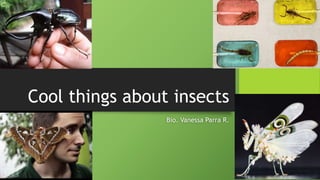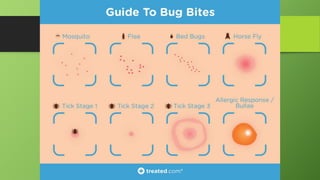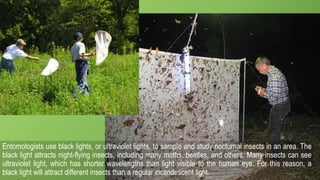Cool things about insects!
- 1. Cool things about insects Bio. Vanessa Parra R.
- 2. Introduction Insects are a class of hexapod invertebrates within the arthropod phylum that have a chitinous exoskeleton, a three-part body, three pairs of jointed legs, compound eyes and one pair of antennae.
- 3. Legs structure and antennae
- 4. Compound eyes made of thousands of tiny lenses allow insects to se 360°. Compound eyes aren’t good at seeing details but they can detect movement very well.
- 5. Anatomy
- 6. Classification • Scientific name: Insecta • Kingdom: Animalia • Phylum: Arthropoda • Subphylum: Hexapoda • Class: Insecta Described by: Linnaeus, 1758
- 9. Life cycle • All insects lay eggs on leaves, sometimes in wáter, inside loggs, underground or even inside other animals. • Insects usually have a short life span of just one day, but others can live up to 50 years! • The protein fiber of silk is composed mainly of fibroin and is produced by lepidoptera larvae to form cocoons. -The best-known silk is obtained from the cocoons of the larvae of the mulberry silkworm Bombyx mori (sericulture).
- 10. Camouflage
- 11. Mimicry
- 13. size
- 18. Benefits
- 21. Fruits and vegetables that are produced by pollination of bees.
- 22. Hungry?
- 23. Insect bites can carry diseases
- 25. Harmful insects for crops
- 26. Insect traps For flying insects especially butterflies, for underground arthropods, for crawling insects.
- 27. Entomologists use black lights, or ultraviolet lights, to sample and study nocturnal insects in an area. The black light attracts night-flying insects, including many moths, beetles, and others. Many insects can see ultraviolet light, which has shorter wavelengths than light visible to the human eye. For this reason, a black light will attract different insects than a regular incandescent light.
- 28. Biodiversity • Investigate • Select traps and sites • Collect • Treat • Analyze • Share knowledge




























